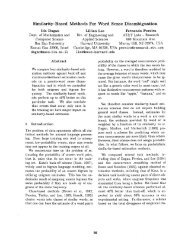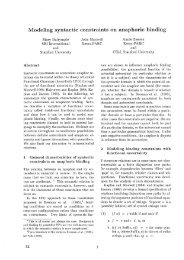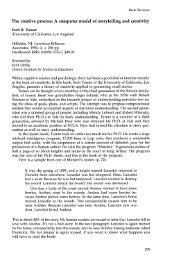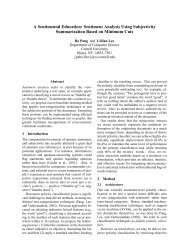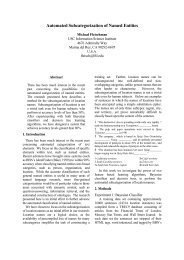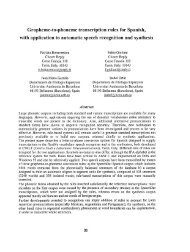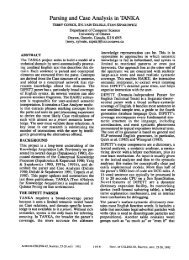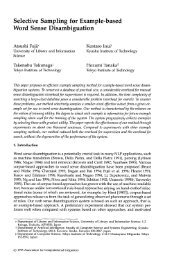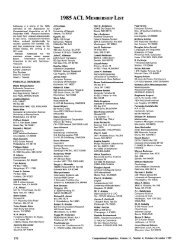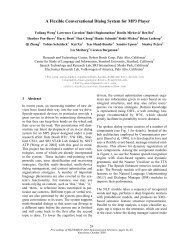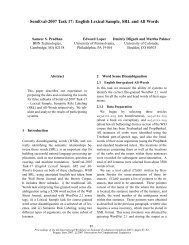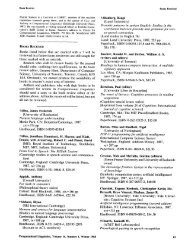CAN COMPUTERS HANDLE ADVERBS?
CAN COMPUTERS HANDLE ADVERBS?
CAN COMPUTERS HANDLE ADVERBS?
Create successful ePaper yourself
Turn your PDF publications into a flip-book with our unique Google optimized e-Paper software.
<strong>CAN</strong> <strong>COMPUTERS</strong> <strong>HANDLE</strong> <strong>ADVERBS</strong>?*<br />
SUMALI P1N-NGERN CONLON<br />
Dept. of Management and Marketing<br />
University of Mississippi<br />
University, MS 38677, U.S.A.<br />
601-232-5470, mksumali@vm.ec.olemiss.edu<br />
ABSTRACT<br />
The adverb is the most complicated, and<br />
perhaps also the most interesting part of speech.<br />
Past research in natural language processing,<br />
however, has not dealt seriously with adverbs,<br />
though linguists have done significant work on<br />
this word class. The current paper draws on<br />
this linguistic research to organize an adverbial<br />
lexicon which will be useful for information<br />
retrieval and natural language processing<br />
systems.<br />
1. INTRODUCTION<br />
There have been many studies on nouns,<br />
verbs, and adjectives in NLP systems. Adverbs<br />
have received far less attention.<br />
It is very difficult for natural language<br />
processing (NLP) systems to handle adverbs<br />
because of the large number of syntactic roles<br />
that adverbs can assume in sentences. Adverbs<br />
can modify verbs, adjectives, adverbs, clauses,<br />
or the whole sentences. Adverbs obey<br />
complicated positional and selectional<br />
restrictions. Many adverbs change meanings<br />
when they change their positions in sentences.<br />
Despite this complexity, linguists have made<br />
significant progress developing a comprehensive<br />
set of adverbs classifications, and elucidating<br />
* This research was partially supported by the<br />
National Science Foundation under grant IRI-<br />
8704619. Our thanks also to Collins Publishers<br />
tot permission to use the dictionary tapes.<br />
MARTHA EVENS<br />
Dept. of Computer Science<br />
Illinois Institute of Technology<br />
Chicago, IL 60616, U.S.A.<br />
312-567-5153, csevens@iitvax.bitnet<br />
the semantic and syntactic properties of these<br />
different classes of adverbs.<br />
In this study, we give some indication of<br />
how a sophisticated and well structured<br />
adverbial lexicon can help NLP systems to<br />
handle adverbs. Our lexicon builds on the<br />
work of several linguists. Their work has<br />
helped us to organize information about adverbs<br />
from the Collins English Dictionary (CED) and<br />
other sources. The adverbial lexicon is<br />
organized using the Oracle Relational Database<br />
Management System.<br />
Semantic classes of adverbs and<br />
selectional restrictions are discussed in Section<br />
2. Section 3 treats functional classes and<br />
describes some of the properties of certain<br />
functional classes of adverbs. Section 4<br />
presents some possible applications. Finally,<br />
Section 5 concludes.<br />
2. SEMANTIC CLASSIFICATION OF<br />
<strong>ADVERBS</strong> AND SELECTIONAL<br />
RESTRICTIONS.<br />
With minor variations, Jacobson [1964]<br />
and Quirk et al. [1985, p438-74] classify<br />
adverbs semantically as: adverbs of time,<br />
manner, degree, location, direction, transition<br />
and hedges. Adverbs of time, for example,<br />
answer questions such as "When?," "How<br />
often?," "How long?." Some examples of<br />
adverbs in this class are "before," "during,"<br />
"now," "forever," "seldom," etc. Adverbs of<br />
manner answer questions like "How?" and "In<br />
what manner (way)?" Examples are "quickly,"<br />
AcrEs DE COLING..92, NANTES, 23-28 AO~r 1992 1 i 9 2 PROC. OF COLING-92, NANTES, AU¢I. 23-28. 1992
"like," "together," and "without." Hedges<br />
indicate fuzzy restrictions such as "essentially,"<br />
"sort of," and "virtually" [Lakoff, 1972].<br />
We have classified adverbs by<br />
systematically analyzing CED definitions.<br />
More details on this process can be found in<br />
Conlon et al., [1990] and Pin-Ngern [1990].<br />
These semantic classes are stored in our<br />
adverbial lexicon as in Table 1.<br />
AD V_ CED (_W__QR~,H/ G #, E~_I~S__F~,<br />
8UBSENSE#,SEMANTIC CLASS)<br />
about<br />
actually<br />
between<br />
down<br />
evidently<br />
1 2 l DEGREE, TIME<br />
1 1 1 MOOD<br />
1 2 2 PLACE, DIRECTION<br />
1 2 7 POSITION<br />
1 1 1 MOOD<br />
Table 1. Adverb classification from CED<br />
The first line indicates that in CED, the<br />
adverb "about" with homograph number 1,<br />
sense number 2, and subsense number 1<br />
belongs to the flggr~ and time class. (To<br />
facilitate exposition, the tables here and below<br />
are not normalized.)<br />
Huang [1975] provides a similar<br />
classification of adverbs based on semantic<br />
usage with verbs. These classes of adverbs<br />
include:<br />
State of ~ ~ . Adverbs in this<br />
group indicate a participant's state of mind.<br />
Examples are ~ and ~ in the<br />
following sentences:<br />
He rf_aLf.Ra~ stepped into the room.<br />
Mary was F_JllLegl2 taken advantage of...<br />
vA.d.x.cz~. These adverbs<br />
express an evaluation of the actor's<br />
participation in the event such as "clumsily" in<br />
"He clumsily stepped on the snail."<br />
of ]~5.UR. These describe<br />
aspects of the result of an event such as the<br />
adverb "correctly" in the sentence "He spelled<br />
the words correctly."<br />
Huang's classifications can also be<br />
incorporated into Table 1.<br />
These adverb classifications can be<br />
extremely useful to NIP systems, in particular,<br />
in the statement of selectional restrictions (or<br />
preferences). Huang describes a number of<br />
selectional restrictions between adverbs and<br />
other parts of speech. Some examples are:<br />
Adverbs of manner or direction can modify<br />
verbs of motion.<br />
Adverbs of result are proper to<br />
accomplishment and achievement verbs.<br />
Time and locative adverbs usually occur in<br />
action sentences and specify the temporal and<br />
spatial circumstances of the events.<br />
Degree adverbs express the degree or extent<br />
of a certain quality or state and presuppose an<br />
analysis of grading properties in the semantics<br />
of adjectives in particular.<br />
Conjunctive adverbs are used in almost the<br />
same way as conjunctions.<br />
This type of information should help<br />
text generation systems to select appropriate<br />
types of adverb to suit nouns, verbs, adjective,<br />
and adverbs which have already been chosen.<br />
It may also be useful for resolution of<br />
ambiguity in natural language understanding<br />
applications (see Radford [1988, p372] for an<br />
example of a sentence in which selectional<br />
restrictions resolve ambiguity). Information<br />
about selectional restriction are stored as in<br />
Table 2.<br />
ACTES I)E COLING-92, NAN'rE.S, 23-28 AO~" 1992 1 1 9 3 PROC. OF COLING-92, NANTES, AUG. 23-28, 1992
ADV_MANNER~,H/G#,~F~,<br />
~UBSENSE#,VERB,SENTENCE)<br />
clumsily<br />
slowly<br />
1 1 1 dynamic action<br />
1 2 1 dynamic action<br />
Table 2. Selectional Restrictions for Adverb<br />
of Manner<br />
From the above examples, "clumsily"<br />
and "slowly" can modify dynamic verbs and<br />
action sentences.<br />
3. FUNCTIONAL CLASSIFICATION<br />
AND THE SYNTACTIC BEHAVIOR OF<br />
<strong>ADVERBS</strong><br />
Jacobson [1964] groups adverbs into<br />
four major functional classes: modifying<br />
adverbs ("L.I/¢...~ he is ~ careful"),<br />
complementary adverbs ("Please come ~'),<br />
referential adverbs (" This section, in particular,<br />
is important"), and conjunctive adverbs ("He<br />
will not leave unless she asks him to").<br />
Adverbs that function as modifiers, in<br />
turn, can modify verbs ("He spelledr,~_rLeC~"),<br />
adjectives ('They are ~ tall"), other adverbs<br />
("He works ~ well"), or even clauses<br />
and the whole sentences ("ForCunat¢ly he was<br />
not drunk").<br />
These functional classes help to organize<br />
knowledge representation schemes involving<br />
adverbs, and are also essential for<br />
understanding the syntactic properties of<br />
adverbs. Jackendoff, for example, classifies<br />
adverbs as subject-oriented, speaker-oriented<br />
(sentence), and manner adverbs, and represents<br />
the meaning structures of these adverbs in<br />
essentially prolog form as follows:<br />
Adverb class: Sentence<br />
Prolog-like formula: ADJ(f(Np1,...,NPa))<br />
Example: EVIDENT(WALKED(JOHN,IN))<br />
It is evident that John walked in.<br />
Evidently, John walked in.<br />
Adverb class: Subject-oriented<br />
Prolog-like formula: ADJ(Npi, f(NP 1 ..... NPa))<br />
Example: CLUMSY(FRED,<br />
DROPPED(FRED,THE BOOK))<br />
It was clumsy of Fred to drop the book.<br />
Clumsily, Fred dropped the book.<br />
Adverb class: Manner<br />
Prolog-like formula: [f/ADV](Np1,...,NP n)<br />
Example: [RAN/QUICKLY] (SUE,HOME)<br />
Sue quickly ran home.<br />
Figure 1.<br />
Huang uses similar prolog-like formulas to<br />
represent the semantic structure of adverbs.<br />
This same functional classification also<br />
allows Jackendoff to derive positions of adverbs<br />
by using parse trees. According to Jackendoff,<br />
sentence adverbs must be attached to an S-<br />
node, while manner adverbs are attached to VP<br />
nodes. Thus the sentence adverb "evidently"<br />
can appear in positions such as the following:<br />
S<br />
ADV NP VP<br />
A<br />
V PP<br />
Evidently John walked in the store.<br />
Figure 2.<br />
ACRES DE COLING-92, NANTES, 23-28 not~W 1992 I 1 9 4 PROC. OF COLING-92, NArcrEs, Act;. 23-28, 1992
S<br />
NP ADV VP<br />
V<br />
PP<br />
"d 1 walked in the store.<br />
John evl ent y<br />
Figure 3.<br />
A similar parse tree could be constructed for<br />
"John walked in the store, evidently." On the<br />
other hand, the sentence *'John walked<br />
evidently in the store," is impossible because<br />
the parse tree does not allow "evidently" to be<br />
attached to the S node (see figure 4.)<br />
NP ~ VP<br />
*John walked evid<br />
V ADV PP<br />
Figure 4.<br />
fly to the store<br />
For a similar discussion, see McCawley<br />
[1988, p631=40] and Radford [1988, p73, 93].<br />
Classification of adverbs by functional class<br />
is gwen in tables such as Table 3.<br />
ADV_MOD W(_WQ_~_,H_H_LC.~,SENS~,<br />
SUBSENSE#,MODIFYING_CLASS)<br />
evidently 1 1 1 sentence<br />
happily 1 1 1 sentence, speaker, manner<br />
clumsily 1 1 1 subject, manner<br />
Table 3. Classifications of Modifying<br />
Adverb Based on Modification Class<br />
Additional information about adverbial<br />
positions in sentences has been collected by<br />
Jacobson [1964]. This information should<br />
supplement the information in Table 3, and<br />
should also be helpful for information retrieval<br />
and NLP applications. This information is<br />
organized as in Table 4.<br />
ADV-JACOBSON(~_,H/G#,SENS~,<br />
SUBSENSE#,POSITION)<br />
after 1 2 1 E4<br />
constantly 1 1 1 M1, M3, M4, El, E5<br />
exactly 1 1 2 M3, M4<br />
otherwise 1 2 1 M3, El, E4, E5<br />
Table 4. Adverb Positions in Sentences<br />
Collected by Jaeobson<br />
Thus, "constantly" is found in "middle" and<br />
"end" positions. More details about each<br />
position can be found in Jacobson [1964].<br />
4. APPLICATIONS<br />
A sophisticated adverbial lexicon should help<br />
NLP systems to handle adverbs appropriately.<br />
NLP systems will be able to use information in<br />
the adverbial lexicon in parsing, language<br />
understanding, and text generation systems.<br />
Suppose, for example, that a parser has to<br />
parse a sentence of the form: "John [Adv]<br />
walked to the store." The parser can determine<br />
how to treat the adverb by looking in the<br />
lexicon to see whether the adverb is a sentence<br />
or a verb phrase adverb. For example, if<br />
"quickly" is the adverb in the sentence, it is a<br />
manner adverb, so it should be attached to the<br />
verb or verb phrase node. On the other hand,<br />
if the adverb is "evidently" then it is a mood<br />
adverb (speaker oriented sentence modifier),<br />
and so, should be attached to the S node.<br />
ACRES DE COLING-92, NANll~S, 23-28 AO~' 1992 1 1 9 5 t'ROC. O1: COLING-92, NANTES, AUG. 23-28, 1992
Once the sentence has been successfully<br />
parsed, the language understanding system can<br />
then create prolog-like formulas of the form<br />
indicated in Figure 1. Similarly, the text<br />
generation system should be designed to take<br />
prolog-like formulas such as those in Figure 1<br />
and successfully translate them into natural<br />
language. The functional class then places<br />
restrictions on the position of the adverbs, as in<br />
Figures 2, 3, and 4.<br />
Finally, selectional restrictions can be used<br />
to reduce lexical ambiguity in language<br />
understanding systems, and assist in word<br />
choice in text generation (see Section 2).<br />
5. CONCLUSION<br />
NLP systems can handle adverbs, if the<br />
adverbial lexicon provides enough relevant<br />
information with appropriate knowledge<br />
representation techniques. The tables in our<br />
lexicon include, among others,<br />
Table 1: Semantic classifications of each<br />
adverb.<br />
Table 2: Selectional restrictions.<br />
Table 3: Modifying class (sentence, speaker,<br />
manner, etc.).<br />
Table 4. Jacobson's dictionary of adverb<br />
placement.<br />
This adverbial lexicon can be used in<br />
combination with Tables for other parts of<br />
speech to implement NLP systems.<br />
These tables, with others, should allow NLP<br />
systems to break down the intimidating<br />
complexity of the adverb class, and so, handle<br />
parsing of sentences with adverbs, adverb<br />
placement, knowledge representation related to<br />
adverbs, and selectional restrictions between<br />
adverbs and other parts of speech.<br />
6. REFERENCES<br />
Conlon, Sumali Pin-Ngern, Martha Evens, and<br />
Thomas Ahlswede, 1990. "Generating a<br />
Lexical Database for Adverbs." In Proceedings<br />
of the University of Waterloo Centre for the<br />
New Oxford English Dictionary. October 28-<br />
30, p95-I09.<br />
Huang, Shuan-Fan, 1975. A Study of Adverbs.<br />
Mouton, the Hague.<br />
Jacobson, Sven, 1964. Adverbial Positions in<br />
English. Dissertation, Uppsala, AB Studentbok,<br />
Stockholm.<br />
Jackendoff, Ray, 1972. Semantic Interpretation<br />
in Generative Grammar. MIT Press. p47-107.<br />
Lakoff George. 1972. "Hedges: A Study in<br />
Meaning Criteria and the Logic of Fuzzy<br />
Concepts." Proceedings of the Eight Regional<br />
Meeting of the Chicago Linguistic Society.<br />
April 14-16, p183-228.<br />
McCawley, James D. 1988. The Syntactic<br />
Phenomena of English. The University of<br />
Chicago Press.<br />
Pin-Ngem, Sumali. 1990. A Lexical Database<br />
for English to Support Information Retrieval,<br />
Parsing, and Text Generation. Unpublished<br />
Ph.D. Dissertation, Computer Science Dept.,<br />
Illinois Institute of Technology. Chicago, IL.<br />
Quirk, Randolph, Sidney Greenbaum, Geoffrey<br />
Leech, Jan Svartvik. 1985. A Comprehensive<br />
Grammar of the English Language. Longman.<br />
Radford, Andrew. 1988. Transformational<br />
Grammar. Cambridge University Press.<br />
AcrEs DE COLING-92, NANTES, 23-28 AOUr 1992 1 1 9 6 PRoc. OF COLING-92, NANTES, AUG. 23-28, 1992



